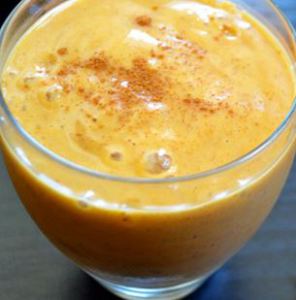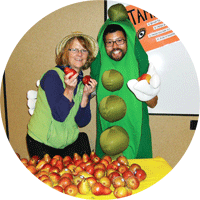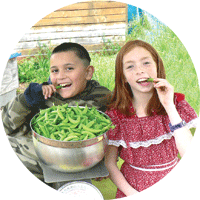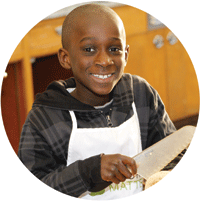
Puppy Power encourages reading on the Sand Point Campus
For families who have experienced homelessness, finding the time and money to participate in afterschool programs can be challenging. However, these activities and programs play an important role in building a foundation for growth and healing after families enter permanent or transitional housing.
With this in mind, staff at Brettler Family Place and Sand Point Housing have been busy building relationships with community program providers to make sure that the children have opportunities to learn and enjoy their childhoods.
Joanna Tarr, a Children’s Case Manager at the Sand Point Campus, is grateful for the wealth of events and activities community partners and local programs provide. “Brettler Family Place has a small staff,” Joanna says, “so outside programs are very important.” Once all the construction is complete, Sand Point Housing and Brettler Family Place is estimated to house up to 250 children. Community partners’ and volunteers’ continued support is greatly appreciated and necessary to ensure the kids receive the best opportunities.
“Offering a variety of activities,” explains Joanna, “ensures the kids have the opportunity to find what they want to do in their lives, gives them a lot of interests, keeps them busy and active, and creates opportunities and positive experiences they might not have otherwise.”
The activities and programs vary wildly. Some kids have dirtied their hands refurbishing old bikes (a program at the Cascade Bike Club) and building remote control cars, while others play sports, learn to cook nutritious meals (Cooking Matters and Apple Corps), or create works of art (curriculum provided by A Window Between Worlds as a means to use creative expression to overcome trauma). As Joanna states, “You never know what’s going to catch a kid,” and so the more exposure to different arts and occupations, the more possibilities each child has to find a passion, deal with stress, and learn skills for the future.
There are plenty of ways for the children to study. Kumon, a learning center in University Village, provides free program admission for the Sand Point children who are able to make it out to their location. Local high school students and adult tutors also volunteer their time four times a week to tutor the kids and help with homework. Science and engineering events and exhibits, provided by the Museum of Flight and Pacific Science Center, have also been held onsite.
Perhaps the most adorable educational program at The Sand Point Campus is offered by Puppy Power, a 4-H group that trains service pets. Once a month, kids and canines convene for an hour-long reading session. The relaxed atmosphere and open puppy ears encourage reading and help the children keep up with school reading assignments.
Building life skills and teaching cooperation is also a focus. The Girl Scouts have been an integral part of learning and fun in the community. Two times a week, the Girl Scouts nurture confidence and responsibility through leadership training, cooperation activities with the troop, community service projects and, of course, the peddling of their scrumptious cookies. In acknowledgement of their hard work and progress, the girls of Brettler have performed the flag-raising ceremony at a Mariners game and at the Girl Scouts’ annual luncheon.
The Mountaineers have been active with Sand Point kids as well – crafting a new generation of fit and rugged Pacific Northwest outdoorspeople. With the help of University of Washington volunteers, the Mountaineers open their facility and offer their expertise to teach the kids rock climbing, survival, first aid and navigation – all of which culminates in a final ‘survivor’ event.
In addition to keeping minds sharp, the programs keep bodies busy. The recently finished Tennis Center Sand Point contributes tennis instructions for kids during half-day and no-school days, and even offers exemplary students scholarships for regular classes. Soccer and football are staple activities for many of the kids, and the kids have even canoed and kayaked on Lake Washington. The local YMCA also opens their facilities to the kids at much appreciated discounts, and the City of Seattle Magnuson Community Center holds events and activities at Brettler throughout the year including hiring and training teens to work as counselors at the summer camps. This amazing program provides teens with jobs skills and experience, and gives the younger children a productive way to spend the summer.
While it’s never certain which activity might ignite a passion or spark a future career, we are certain of the influence these activities can have on the kids. The success rate at Brettler is high, according to Joanna. “There’s a great sense of community. There’s a Brettler clique. The kids have bonded to each other and support each other.” While she admits a large part of the supportive relationship comes from the stability permanent housing affords, Joanna, who has been at Brettler practically since it opened, concedes she’s seen a change. “The kids get to know each other in different ways than if they were just neighbors. When they participate in all these activities they get to know each other on a deeper level – doing activities like rock climbing where they have to support each other.”
This slideshow requires JavaScript.
We are looking for great volunteers to support our children’s programming at Sand Point! If you’re interested in getting involved or would like more information, please contact our Volunteer Coordinator at volunteers@solid-ground.org or at 206.694.6825.
Filed under: Housing | Tagged: Apple Corps, Brettler Family Place, Cooking Matters, Magnuson Park, Sand Point Housing, youth | Leave a comment »





 The whole idea around nutrition education is that if we can really train children from an early age in all aspects of healthy eating, in understanding the value and benefit of eating balanced, nutritional meals, if we can help children at that young age really start to fall in love with healthy foods – taste it, experience it, and see that it’s good – that enables them to start making healthier choices. That is supportive of food justice.”
The whole idea around nutrition education is that if we can really train children from an early age in all aspects of healthy eating, in understanding the value and benefit of eating balanced, nutritional meals, if we can help children at that young age really start to fall in love with healthy foods – taste it, experience it, and see that it’s good – that enables them to start making healthier choices. That is supportive of food justice.” “Lettuce Link is all about being a community place where people can not only come and learn about growing food, but they can actually experience it,” Gerald says.
“Lettuce Link is all about being a community place where people can not only come and learn about growing food, but they can actually experience it,” Gerald says.



